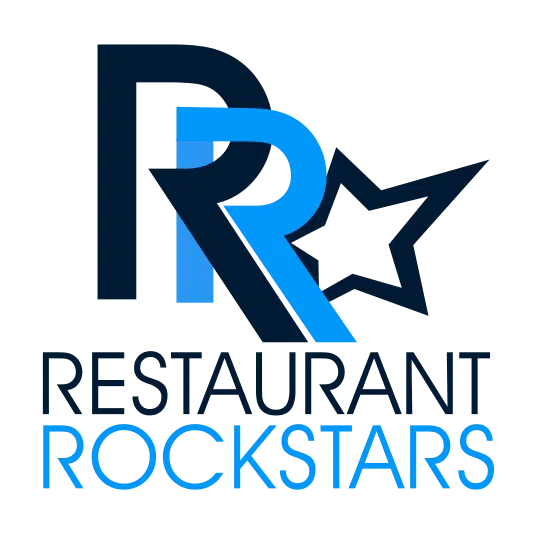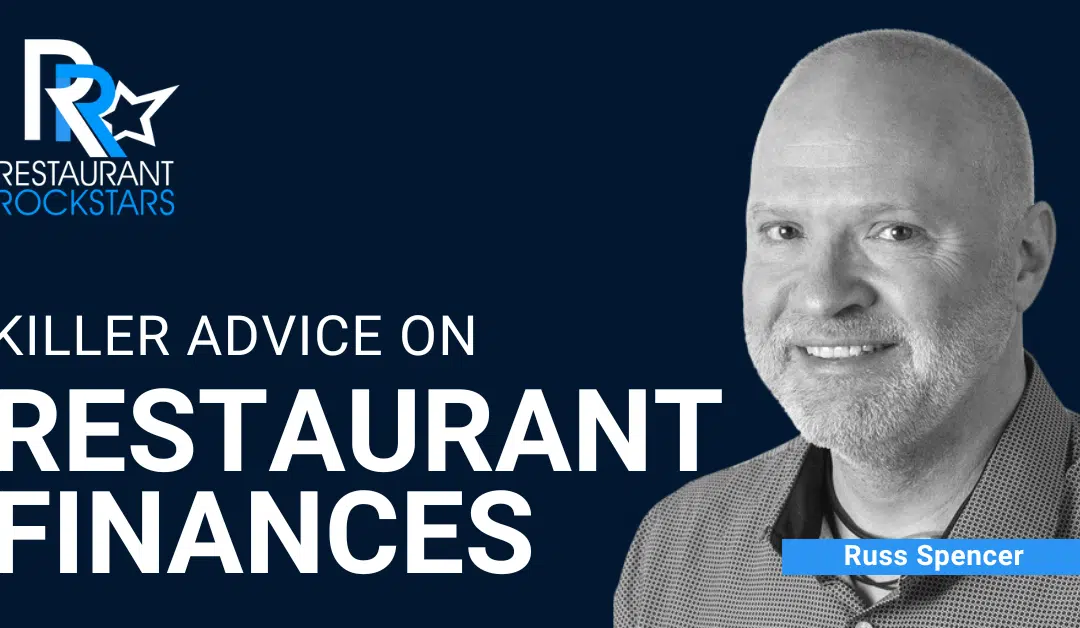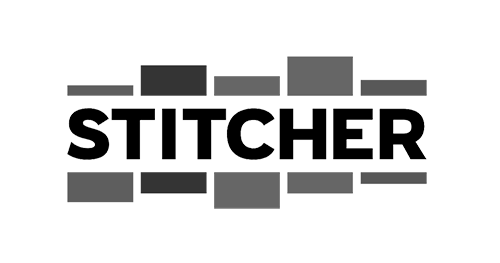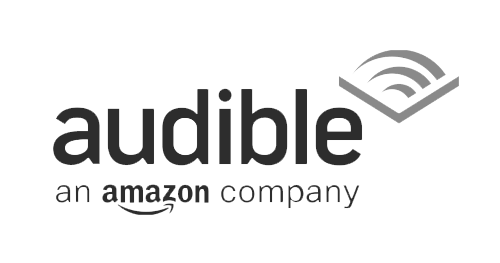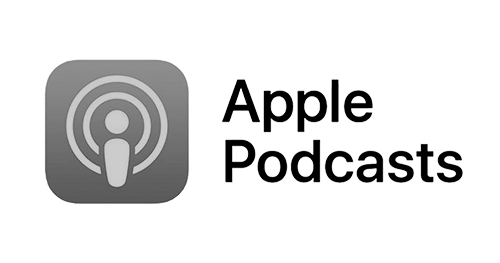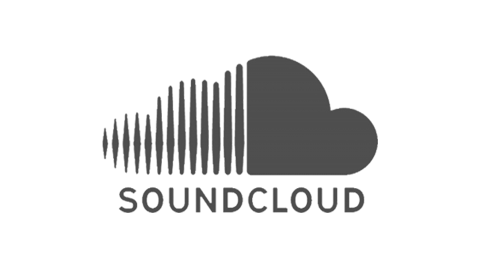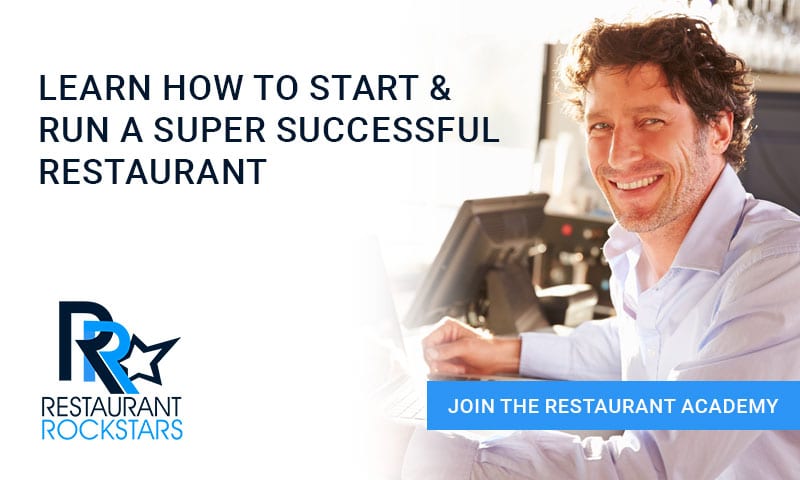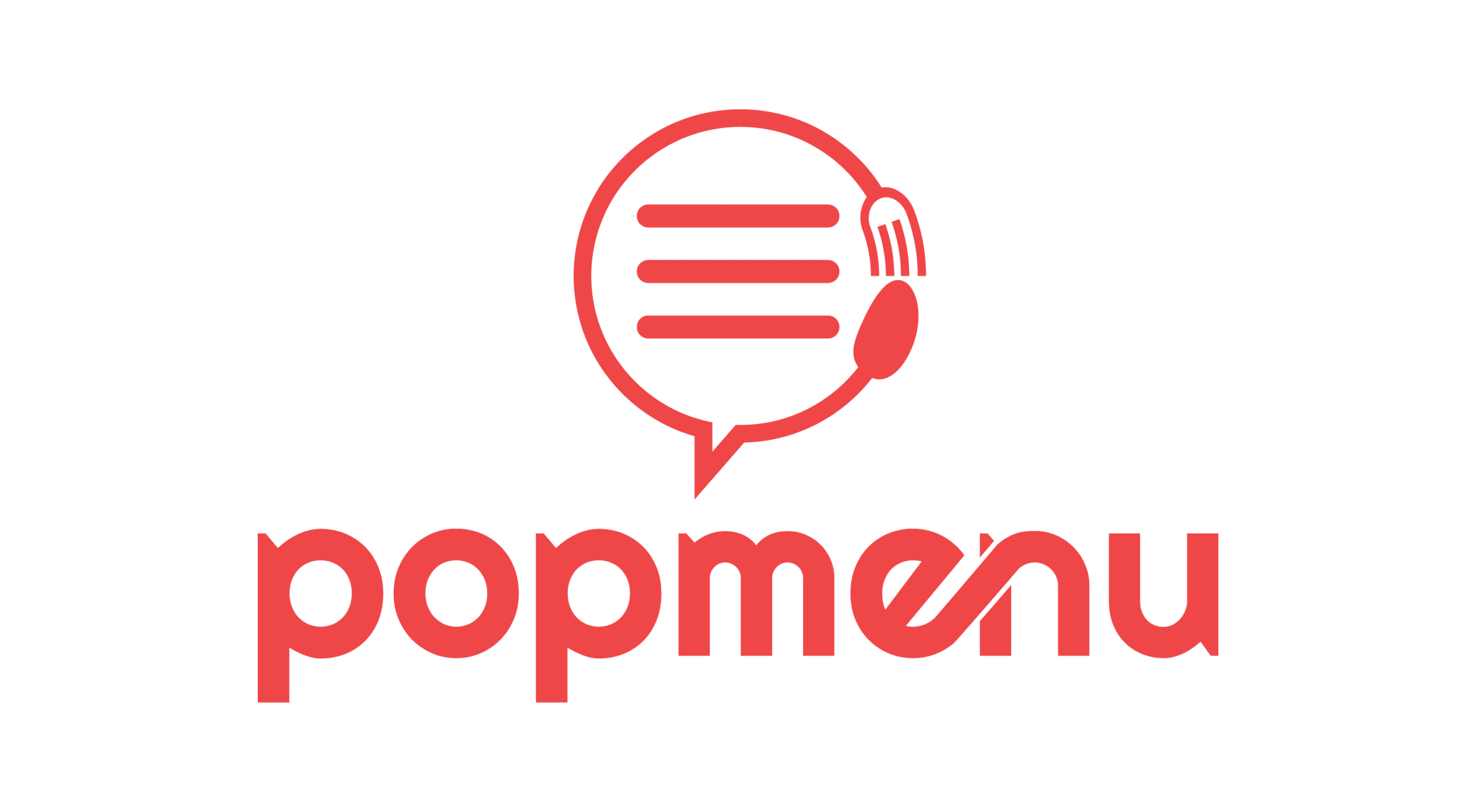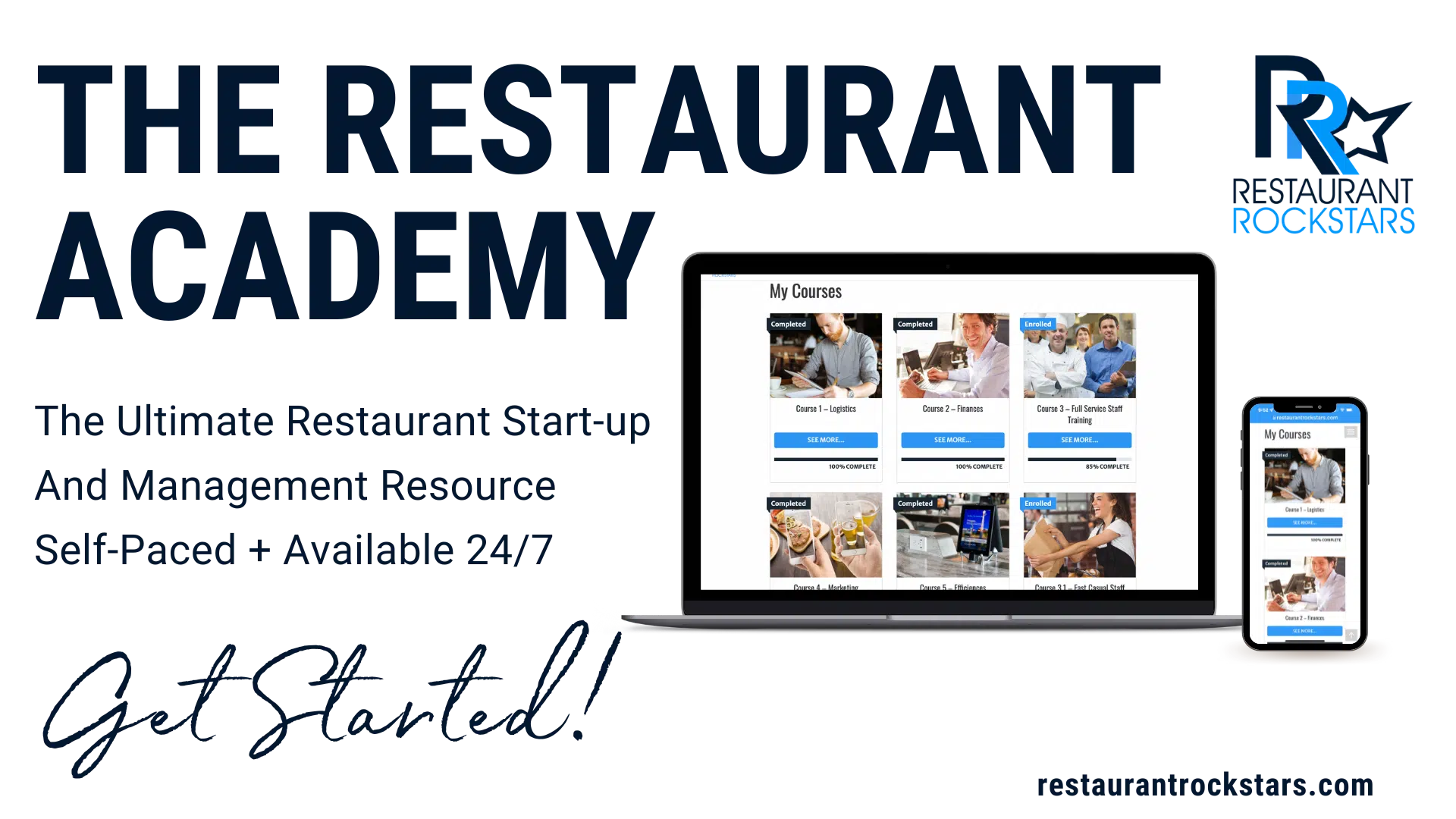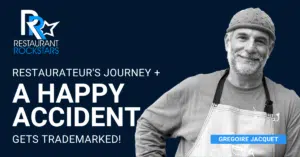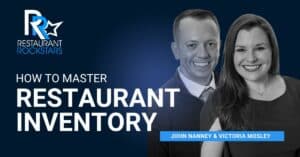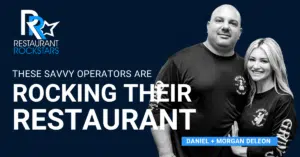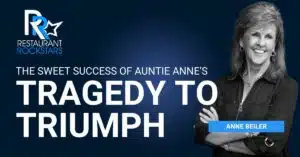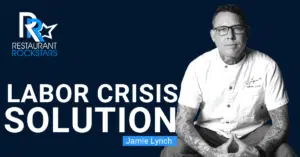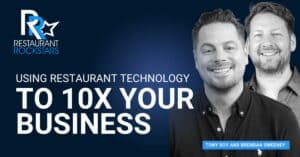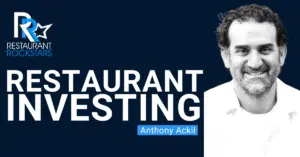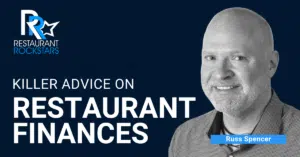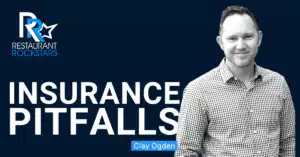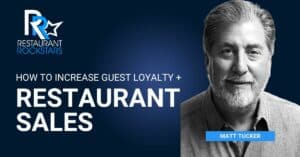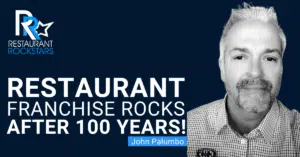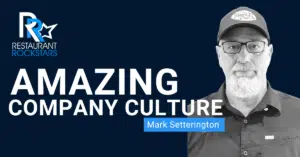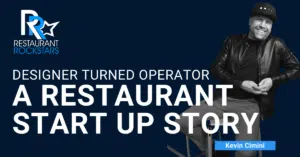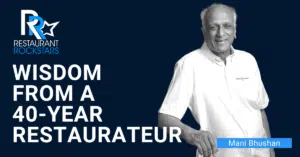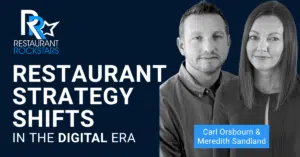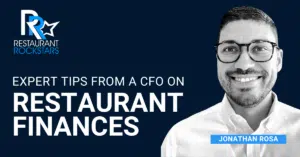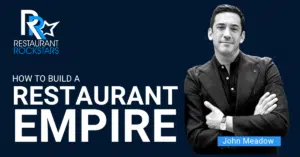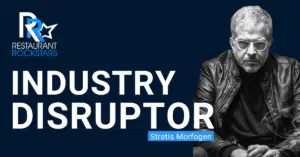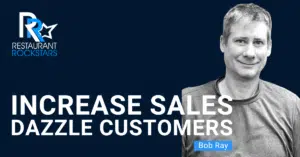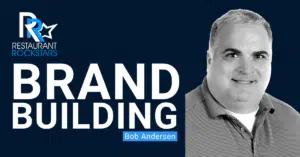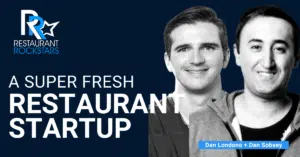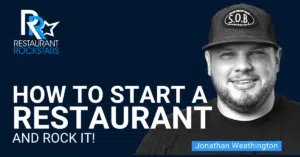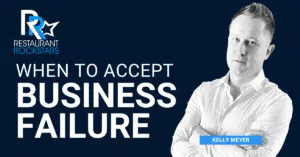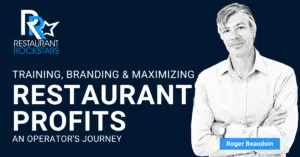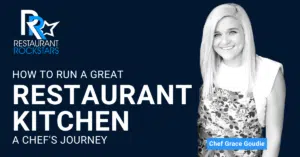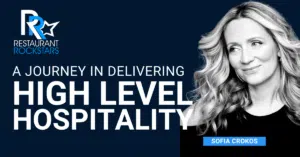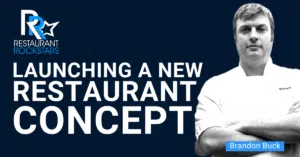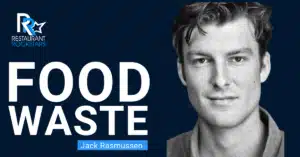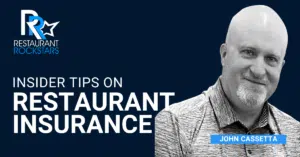Restaurant Rockstars Episode 350
Killer Advice On Restaurant Finances!
LISTEN HERE OR ON YOUR FAVORITE PODCAST PLAYER
Prefer to watch the interview?
Click the video below.
I’m obsessed with restaurant finances, marketing and hospitality and you should be as well.
As a forward-thinking operator, you can learn new things each day that move the needle and immediately work to put them into practice in your restaurant.
In this episode of the Restaurant Rockstars Podcast, I’m speaking with Russ Spencer. He is a true industry professional, a guru of restaurant finances and an old friend whose Senior Director of Restaurant Success for “Craftable”.
Russ has decades of restaurant experience and a selfless dedication to help improve individual operator’s businesses.
Listen as Russ shares:
- Restaurant Profits today vs. pre-pandemic
- The critical restaurant financial systems you need in your operation.
- Big mistakes restaurant owners are making and what to do about it
- The importance of inventory, food cost and all-important profit contribution
- The why and how of menu engineering
- His thoughts on leadership and getting the most from your team.
- The guest value-proposition and raising prices.
This episode is jam packed with golden nuggets and key-learnings about restaurant finances that will get your gears turning and your feet moving.
Watch or listen to this episode, get inspired and go out there and Rock YOUR Restaurant!
Roger
Connect with our guest:
0:00
Build your team, you take care of your team, you retain your team, then everything falls in line, your productivity. I’ve got buddies that run restaurants where their their total all in labor, employee management salary benefits is running 26%. That’s not because they pay less. It’s because they take care of their employees that don’t have turnover. They diverse people to do what more people can do. And so it’s really about the investment and people and if you can stop that turnover, you will then get your labor in line.
0:29
Wow, what an episode we have today. So thanks for being with us. I’m speaking with Russ Spencer, a colleague of mine, an old friend, we’ve worked together in the past. And now we’ve reconnected via this podcast, Russ is the Senior Director of restaurant success for a company called Craftable. And in this episode, we talk about the state of the state what restaurants are going through today. The operational challenges, the rising costs, the labor, the inflation, all the things beyond our control, and what you as an operator can do to combat those rising costs and move the needle and put more money to your bottom line. We’re going to be talking about leadership versus management. We’re going to be talking all about menu engineering, and menu design and how to squeeze every ounce of profit out of a menu. And, you know, ingredients and so much today. I mean, there’s so many key nuggets, and Russ has been in this industry for 30 plus years, and we just talked shop today and again, there’s so much to offer too, so you’re gonna want to stay tuned and not miss it. Thanks to the sponsors this week, pop menu verge funding and the birthday club. So stay with us on with the episode.
1:40
You’re tuned in to the restaurant rockstars podcast powerful ideas to rock your restaurant. Here’s your host Roger Beaudoin.
1:49
Rock Stars, there are many elements to consider when growing your restaurant. are you connecting with diners enough and with the right message? Could your kitchen be putting out more orders than your dining areas have room for? Well, it can be overwhelming, especially when the reason you got into this business is for the food and the people. That’s why restaurants get pop menu. Pop menu is the marketing tech platform designed to make growing your restaurant easy, so you don’t have to grow it alone. With pop menu, you can capture more guests and their preferences through your restaurants website that’s designed to easily collect contact information and data so you can see what your guests love and why they dine with you. Connect and build authentic relationships with guests by using modern technology that personalizes marketing, make all your systems work better together, improve margins and conquer the chaos of your restaurants digital presents pop menu as a special offer for my listeners for a limited time, get $100 off your first month plus lock in one unchanging monthly rate at pop menu.com/rockstars Go now to get $100 off your first month at pop menu.com/rockstars. I’ve always believed in systems to run a really effective restaurant, they say you have a system if you can walk away and leave your place for a day, a week or a month. And it’s just as successful, just as profitable when you return, if not more. So. Now the staff are really the foundation of this. And it all comes down to the word empowerment, you know, if you’ve got really great people, and if you can develop those people that have your back, and to run it as if they owned it treat everything as if they had to pay for that’s a super powerful system. Once you have the staff in place, it really comes down to three things. It comes down to one staff training, development, recognition and rewards to create what I call your dream team, how to empower your team to think and act like owners and to treat everything as if they owned it, and had to pay for it and to deliver amazing guest service experiences to your customers to serve and sell because sales are the lifeblood of your business, not allowing order takers on the floor. But teaching everyone to recognize opportunities and make suggestions that we know that customers will enjoy and appreciate. It all comes down to training, training training, number two cost controls and maximizing profit. You need to know your critical financial numbers on a weekly basis. And it only takes 10 minutes, but you need to understand these things. How about your daily breakeven how much it costs you to open the doors to your restaurant each day. Inventory is not just walking around and figuring out what your order is that week. It’s knowing the true value of your goods on hand at any given point in time and you need this information to be able to calculate your true food and beverage costs. Your labor costs are also important and running a weekly labor analysis against sales. If you know these things, I can teach you how to maximize your profit and can control your costs. And then number three is what I call marketing firepower and affinity. You know, affinity is defined as a really powerful sense of loyalty and belonging where your customers become raving fans. And they’re like an army of brand ambassadors spreading the word for your restaurant. Well, all of this is included in the restaurant rockstars Academy. If you really want to take your restaurant to the next level, post pandemic, things are heating up, customers are coming back. Now’s the time to really maximize your opportunities, maximize your sales and profits and create that dream team staff. Check it out at restaurantrockstars.com. It’s the restaurant rockstars Academy. Hey, Ross, how are you today? Welcome to the show. Glad you’re here.
5:43
Thanks, Roger. It’s a pleasure to be here. I always enjoy our time together.
5:47
Well, you and I go back many, many years. And you’ve got such experience in this industry. And like me, you’ve got a passion for it. And you’ve, you really enjoy helping others. And this is a challenging business, probably the most challenging business I’ve ever been in. And there’s no disputing that. But you really have gotten into the trenches with a lot of customers. But before we go down that road, Russ, I always start with the hospitality backstory of my guest. And you can take us as far back as you want, whether you’re a teenager, and you’re worked in a restaurant, or whatever it was just and then your career trajectory, and how you got to where you are today and what you’re doing now. So just kind of give us an overview of where it started and what you’ve done. And then we’re going to just talk shop,
6:32
love it, love it. So like many of us, I started in the dish pit the young age of 15. Right, so when I had a little bit of money, so washing dishes bussing tables, worked my way through the system, and once I had managed to navigate my way out of school, I had found a career in the restaurant business. And at the age of 23, I was an operator of my first full service restaurant as a general manager did that for a few years, so combined total of 10 years with that company. So from the age of 15 to 25, I migrated over to a large corporation that was aggressively growing in the southeast and into the Midwest. So I joined their team as we accelerated the growth. And from there, we developed the St. Louis, Kansas City, Missouri Arkansas market. One thing I’ll tell you about corporate America is that while they might not have the passion that an independent has, when it comes to the quality of food, they definitely know how to make money. And that’s through their standard operating procedures, monitoring, measuring and tracking. So I aggressively grew with that company stayed with them for a total of 20 years prior to leaving them to start consulting in 2015. So in 15, I started consulting, working with operators developing those SOPs and finding opportunities within their business, all the way through COVID. Now, in the heart of COVID, I became one of 12 really focused on the Cares Act, how to use the Cares Act, find the money within the program, bring it back into our industry, set our businesses up for success, catapult their business into the future. And I did that until I joined craftable in 2000, or February of this year. Wow. So
8:12
there’s so much to talk about there. But the first thing that comes to mind is the Cares Act, and the amount of money that was available and all the extensive different government programs. That was the salvation of this industry, but it was, you know, really hard for a lot of operators to be in the trenches, just trying to figure out what’s going to happen next to my business states are shutting me down, you know, I can’t open for weeks. And when I do reopen, I’ve got all these restrictions and there and I’ve got staff and do I keep them on payroll, and is it PPP and you know, it was overwhelming. And then they had to be, they had to have their finger on the pulse really quickly when a new program was announced and press that go button online before the program ran out of money. And so many operators lost out on a whole lot of money that may perhaps have saved their business. So I’m hearing that you help them navigate this process. And that you may have single handedly been a salvation to many, many businesses that otherwise would have either failed, gone out of business or wouldn’t have gotten all the money that was available through all those programs. Right. I mean, that’s very noble. And I mean, again, the passion is there, the commitment is there, the experience is there. But it’s like you took this whole industry to another level by virtue of what you were able to help him with. And I’m in awe of that because I went through the process. You know, I bought another restaurant just before the pandemic, I went through all this and thankfully, it’s like I had the wherewithal to focus on that as being the top priority, which saved my business which then allowed me to sell it so I want I want you to tell me a couple of those stories perhaps let’s let’s talk about you know, any story that comes to mind. and have a business and what position they were in, and then you suddenly went in there and, you know, saved the day gave them a Hail Mary, and now they’re succeeding. Now, because of that help anything like that standout, I know people out there would love to hear about it, because it’s inspiring to us. You know,
10:17
it’s, you know, it’s so funny, because we’re in the hospitality industry, right. And so I always say, we’re not necessarily in the food business, we’re in the people business, and that is just taking care of each other. And so I think when this came about the 12 of us, as a team got together and really dove into the government legislation, started understanding how it worked, how to get the most out of it, how to use it, to get the forgiveness and really allocate those funds back into the business to set them up for the future. One comes to mind, I will tell you what the first of it was, it would have been January of 21, I had an operator who had quite a several $100,000 in PPP money, and she failed to us all except for 15,000 of it, and she was comfortable paying that 15,000. Back, when we were able to understand how to apply for forgiveness, the only way you’re eligible for round two is if use 100% of round one, while she thought she was doing the right thing by not using all the money, okay, we were able to go back in and adjust the forgiveness and then find the additional funds for round two, which, if you remember was 40%, more than round one. So when we had that conversation, her feeling was we had about 30 to 60 days of survival left in the bank to before we didn’t know if we were going to make it. And this restaurant was 40 plus years old. So I’d like to think being able to find a way to use that money and then apply it back to her business to be able to set her up for the future not only helped her business, but it helped the 75 employees and their families that were part of it, we were able to bring that money back into the business and not only again, help them get through COVID. But really start evaluating what tech tools resources were available to be able to move their business into a new future post COVID. So it we started evaluating online ordering or websites or menus, you know what tech is out there to help us monitor and measure. So I think pivoting and stopping and looking at how to use those funds in a way that really set them up for an additional 40 plus years, that was rewarding.
12:15
The word that that’s absolutely wonderful. And I think based on what you just said the word is being proactive in this business. And unfortunately, I know you’ve seen it, I’ve seen it as a restaurant coach, it’s like so many, so much of this business, whether you’re a GM, whether you’re an owner, whether you’re any type of leader in this business, it’s more about, you know, putting out the daily fires and being reactive to what happens, oh, the dishwasher just, you know, went on the blink. And it’s like we’ve got to somehow fix or the roof is leaking, or whatever it is, I mean, every day is a new challenge in the restaurant business. But being proactive, takes systems. And I know you’re a big believer in those. And you know, I want to talk about, well, let’s dive into what you’ve done to help other businesses besides the PPP thing. I mean, there’s so many operational challenges, and you’ve got a mastery of those things. What have you seen most often, in some of the businesses, you’ve served either pre pandemic or, you know, after the pandemic, whatever it was, it’s like you’ve worked with a lot of different operators and a lot of different positions and different size restaurants and that kind of thing. What kind of jumps out at you is either mistakes they’re they’re making or just things they’re lacking, that if they had those things in place, they’d be in a much better position. You know,
13:37
it’s, it’s interesting, because I think we all think that sales fix all and, you know, I like to think that sometimes the only thing we put in the bank at the end of the day is the profit we made off of those sales. So it really starts by understanding what your margins are, where your opportunities are, and how to drive them now, there’s there’s really two ways I’ve tried to support a business when it comes to increasing profitability. And the first one is, let’s change your customer behavior. And so what do I mean by that? What I mean by that is to really understand where the margins are on your menu, and how can we encourage our customers to order what drives the maximum profitability, at the same time balancing execution, okay, and defining the integrity of the brand. So I don’t care how profitable it is, if we can’t execute it, then we lose the profitability in the execution. And I don’t care if it’s profitable and easy to execute. If we can’t bring the customer back then it was a one hit wonder and the profitability is lost. So it’s really about understanding where that profit is. And when you understand that profit, then let’s change the behavior of your customer. So how do we do that? And that can be done through the design of the menu. Many times you’ll notice that about 80% of what you sell in a category pretty much defaults to about point percent of that category just because of placement, visual cues like you know call out words sustainability, all natural. That said that if you have a picture of an item and you drive about three 80% More traffic of that item than you would an item without a pitching. So it’s about understanding where that margin is and then leveraging it. So leveraging on the menu, leverage it through social media, leverage it through suggestive selling contest with your staff. So really encouraging customers to order that, again, balancing profitability with execution, and integrity. Now, the second way you have to make money in this business, in these challenging times, is really understanding how to change your behavior. It’s the hardest thing in life to do, right? So you have to understand, what did you use versus what you should have used. And the difference between the two is what we manage, we can’t always change the price of a product, we pay for it back door, that fluctuates in the game of commodities, but we can change how we manage that. And so while we’re dealing with 400 500 items in our inventory, let’s focus on the top 10 or 12, that are driving the largest variance and usage versus theoretical usage, and then fix that waste. I always like to ask people, How often do you count your cash till every day? Okay, do you treat money? Or do you treat food and liquor the same? No, you don’t. And if we were able to treat prime costs being your food, your liquid, your labor the same? Fine, where we’re leaving that money on the table, I can guarantee you an equal straight profit to the bottom line.
16:16
All that makes so much sense to me, Russ, and again, it’s it’s expanding, what I want this audience to hear about what you just said, but how many operators out there are you seeing that are actually taking physical inventory and really know what their prime costs are, and really know which items on their menu are contributing the greatest profit so that they can use that data to move that business forward versus throwing a menu together, because it’s got variety and appeal to the guests. But they have no idea that the profits are all over the place. And that that spread in each category is many, many dollars in that sense. And that, you know, they’re paying the highest wages right now they can’t control like you mentioned, cost of goods is rising labor costs are the higher the highest they’ve ever been. Those are sort of non controllable variables. But what you can control is your menu profit. And, you know, let’s unpack that a little bit more if we can do you see many savvy operators that have this dialed versus a lot of operators just kind of shooting from the hip and hoping for the best.
17:19
Unfortunately, I see him cowboy up if you will, right. And so I think growing up in a corporate environment, we had those SOPs in place, we had the systems, the tools, the tech, we monitored, we measured where opportunities were. And so naturally, I grew up in that environment, as I migrated over to start consulting with independent operators and small regional chains. It’s very unfortunate, those behaviors do not exist. And a lot of times, it’s just due to lack of resources, bandwidth, you know, a team around them to be able to consistently stand it up and track it, but that money’s left on the table. And, you know, it’s like, if I told you, Roger, you had a million dollars in your backyard, you’re gonna go home and look for it tonight, you’re gonna dig and look everywhere. But if I said, Roger, it’s in the back left corner underneath the red tulips, you’re gonna go there and dig and you’ll find where it’s at. So we can find that spot in your yard and your business and dig within it. And we can pull that profit out of it. And unfortunately, most of our operators don’t have the resources to do that. And they really struggle with the team around them to be able to find that technology and stand it up.
18:25
That’s an interesting point. Also, when we go back to that concept called inventory, I know in my experience, I’ve seen a lot of operators that think, oh, that’s just walking around figuring out what the order is that week versus taking the physical counts. But what you related the million dollars in the backyard, it’s under the tulips in the left corner by the fence. It’s like telling an operator, your inventory is like 1000s of dollar bills sitting in there. And you either know it’s there or not. And if you don’t know what’s there, chances are your staff knows it’s there, it’s walking out the back door, you’ve got waste, you’ve got spoilage, you got theft, you got all these things, meanwhile, while your costs and inflation is rising, and it’s like you got so much value there and behind the bar, too. I mean, there’s huge potential for losses there. And that is a critical point that needs to be monitored and analyzed, and knowing exactly that those systems are as efficient as they can be. And unfortunately, there’s a lot of people that don’t either have the bandwidth because they’re trying to put out all the other fires. And this guy didn’t show up today. And now I gotta jump behind the line. And that’s the nature the game today, but it’s like, take a step back. And let’s try to systemize these businesses to give yourself a head start for the future and not just, you know, not just survive, but really try to succeed. Don’t you agree?
19:43
I do. And, you know, you ask the inventory. And again, it’s surprising how many operators don’t take inventory just for lack of time. You know, but they do inventory their cash Tiller every day. And you know, again, I just keep going back to that if you’re $20 short you ask questions. You dig in? And you find out why. And you stop that from happening again. And if we can treat labor, food and liquor the same way, there’s more money left on that, then there is another business. So let’s dig it up.
20:14
No question about it. Let’s talk about profit margins pre pandemic. And now, I mean, there was a statistic maybe four or five years ago that said, You’re doing well in this business, if you had a 10 to 12, or you’re doing okay, if you had a 10 to 12%, net profit margin on sales, and then the pandemic hits. And now suddenly, it wipes out a whole bunch of businesses. And now those that have survived, there’s a whole lot of them out there in the five to 8% range, maybe that’s still accurate data, maybe not, maybe you’ve got a better, more accurate picture. But can you shed some light on that where people are at right now, across the industry.
20:51
So the feeling I’m getting from talking to operators is they’re running anywhere, at best flat to three to 5%. And so the margins have been chewed up. And if you think about the p&l, if you break it down, we have five buckets we have to manage. So you have your food costs, your liquor cost and your labor cost. And when you combine all three of those together, we know that is your prime cost, then you have your overhead which I like to tell everybody overhead is everything that is not food, liquor and labor. And then you have your cam and your common area maintenance, which is the building insurance on the building the taxes. Now we’d like to see that number in a healthy p&l sits somewhere around six to 8% of sales. That number is most often a fixed number and it will decrease as volume goes up your overhead much of your oil that is variable, okay and fluctuates with your sales, that number in a healthy restaurant should sit somewhere around 15 to 18% of sales. Now we do see that number again, there are some numbers in there that fluctuate. If overheads out of line, it’s non perishable, it’s pretty easy to identify where it’s at and reel it back in. So if your electricity is too high, turn your fryers on at 10:45 and not nine, have your trash empty three days a week, not five, do you need the Sunday NFL ticket if you don’t have a bar crowd, right. So if you bought too much bleach just don’t buy as much, that’s pretty easy to identify correct and get back in line where you’re losing your money is when you’ve seen your prime costs being a combination of food, liquor, labor, aggressively rice, pre COVID, we liked that number to be around 55 to 60%. In an average healthy restaurant, post COVID with the cost of goods increasing faster than you can offset them and the cost of labor increasing faster and you can offset it, that number is easily climbed to 65 in some cases as high as 70 75%. So if you’re on 7515, and let’s just say six, your margins are minimal at best operators that are making the money or the operators are able to decrease their prime and push that back down to where it needs to be. And so many times we think that sales fix everything. So if I drive sales, I’m gonna increase profit. But if you’re running 0%, on, let’s just say $2 million, and you focus on driving sales, some of those costs are fixed, most of them are variable are going to fluctuate with sales. So more than likely, you’re going to increase sales and take minimal profit to debate with you. So the focus should be let’s get your prime cost back down to a reasonable number. So if we can run that number of 60 65% and post COVID world, find the leverage on the on the menu, drive those profits, then we can go grow sales from there. So if again, if I’m doing 2 million at 2%, I’d much rather do let’s just say 2 million at 10%, and then move it to 2.5. So it’s about understanding those numbers and then creating the plan to go after the sales.
23:31
Yeah, I mean, that’s really simple math, when you think about it, not everybody’s a CPA, but you don’t need to be to look at and understand a p&l. But if you talk about those five buckets, Russ, and if we’re talking about prime costs, taking up three of those, and if a healthy prime cost is 60%. That means let’s break it down. That’s like 60 cents of every dollar of sales is going to those top three. And that only leaves 40 cents for the other two buckets, your overhead and your cam. So that’s as simple as it gets. But you’re right. If you can manage those things and call that a system and monitor it regularly, you’re going to be a much better position that if geez, I don’t know what prime cost is. I don’t take inventory. I don’t know my food cost is I’m filling my seats. And I’m busy restaurant but my bank accounts not growing. I wonder why. You know, it’s like we see this far too often. And this is sort of a wake up call. I mean, there’s a lot of dialed restaurants out there. Don’t get me wrong, but for those operators that aren’t doing this, the fundamentals I call them this is your future right here. Take time make it a priority, and I’m really glad that you shared that. Let’s talk about the menu for a moment because menu engineering is an art and a science unto itself. And I think it it really began with okay, I’ve got a menu and it’s got a left side and a right side and a top and a bottom and all that kind of stuff. And yeah, the guests it automatically goes to the top right corner and so many restaurants stop there. And then they think Okay, I’m just gonna put what I want to sell at the top right, and then the bottom left and all this stuff, but the simplest thing to do is to call attention to your most profitable items, once you know what they are, and it takes costing out every item, and keeping those costs accurate, because let’s face it fluctuating prices, inflation, one day, you’re paying this for, you know, fryer oil, and avocados and steaks. And the next day you’re paying this and keeping on top of those cost sheets is pretty important. But let’s talk about where menu engineering really is today that goes beyond that. And there’s so many things I’m sure you can share about that.
25:38
I love it. It’s a topic I’d love to dig into. Because not everything on the menu is created equally, right. So it’s again about understanding the profit on each item, balancing the execution and representing the integrity of the brand while selling it. And when you know that then again, to your point, how do you design the menu to drive those items. Now, here’s where we fell, okay, we might design the menu, but we don’t go back and monitor or measure the impact those changes make. And I always like to say it’s like going to the doctor, if I go to the doctor and he draws my blood, he tells me what to pay attention to. And if he’s concerned about something, then he’ll turn around and tell me to come back nine months or nine, we’ll say nine weeks, you know, 90 days later and checks in and make sure that what we did is working. So if we’re going every change on a menu has a consequence good or bad. So if I move an item here, or I increase this price by this, you could be creating a consequence, that’s unintentional, you could move somebody to an item that’s less profitable, you can move traffic to an item that’s harder to execute. So understanding what those changes did to your p&l. Now one of the things that I have found is very helpful is understanding the contribution of profit. So a lot of times when you get stuck on, let’s just say I have to run a 30% for cost. Well, again, what do you put in the bank, you put in the bank the profit, I’d much rather sell a ribeye, it’s a 40%. And yield 24 Then sell cheeseburger at, say 25 and yield eight, because I need three cheeseburgers equal the same profit is one ribeye. So it’s understanding that right but here’s the challenge. Do you measure the contribution of profit of how many ribeyes you sold? Because if I sold six cheeseburgers and to ribeyes okay, it’s the same. But if I sold 12 cheeseburgers, and to ribeyes the contribution of profits greater, so it’s about understanding that contribution to profit. Now, here’s one number we all look at, we always look at sales we measure what the average spend is per customer. So we do total sales divided by total guests to understand what the total guest average is PGA. Well, one number that I have found that truly measures the impact of the menu is to do the same mathematical equation with profit. So if I understand the contribution profit, every item has multiplied by how many sold divided by how many customers I served, then I understand the contribution of profit each item drove I understand the average gross profit of my customers. And now as I make changes on the menu, if that number goes up, let’s just say the profit you and I go out to eat, we spent 100 bucks 30% food cost yield profit 70 divided by two, the PG are their average gross profits 35. If we make changes to the menu, and we change the customer’s purchasing behavior, maybe we increase the price to where they stopped ordering desserts. Or maybe we increase the price to where they want to something different on the menu, what we need to go back and measure is the contribution of profit, because if that number went from 35, to 32, then we need to stop the bleeding immediately and figure out what happened and steer it the other way. If that number went from 35 to 37, then we want to continue to multiply that behavior in the preceding 90 days. And I encourage people to look at that number about every 90 days, maybe you don’t adjust your menu but once or twice a year, but you should look at the contribution and the average gross profit per customer every 90 days. That is
28:58
really powerful stuff. And this brings to mind, I had two recent coaching clients that I worked with, and what you spoke to is exactly how I analyze their business. But I created this template that if I’ve got recent costing sheets that that are up to the minute on what they’re paying for things, we can go into a point of sale system, it can give us sales data over a date range, six months, a year, whatever. I like a lot of data because it’s really telling. But if I can rank those items on this template in terms of most profitable to least profitable in each category, and then plug in volume of sales of each one, and then hit the go button, it’s going to automatically calculate in every category, the popularity of items versus the profitability and how much the spread difference is and how much money is lost whenever they sell this versus that in potential profit. So just to cap this off, it’s really this is eye opening for an owner when you share this information but when Just say the last two clients that I that I did this for were just under $3 million for us. One was like 2.7 mil, the other was 2.9 mil close enough. After we did this exercise, the potential loss profit in the past year recently was like $340,000 For one, and 368 for another. And it’s like you share this data with them. And it’s like, I had no idea. And it’s like, wow, simply because in most categories, they’re losing money, because lower profit items take sales away from higher profit items. So what you’re talking about is rock solid information. And I think every operator needs to analyze, but it begins with up to the minute costing sheets, knowing which items are the most profitable, you can go redesign a menu really quickly that boxes in or highlights those most profitable items, you can train your staff to suggest those that all the tables, My favorites are, you know, these are guest favorites, whatever they say. And suddenly you can stop the bleeding and raise that needle on bottom line profit. That’s the first thing you said, this whole industry is sort of hyper focused on food cost versus what’d you say the profit contribution? And I’d really like you to reiterate that again. Because like you said, I would rather sell ribeyes. But you know, people are I gotta have a 28% food costs when I’m thinking I’d rather have a 40% food cost and sell lots of steak because the profit contribution is so much greater than like you said, the cheeseburger. So that was a vital piece of the mix. Is there more that we need to say about that? Or do you think it’s been covered?
31:41
No, I think you know, I think you’re spot on. Again, what do you put in the bank, at the end of the day, after you sell the product, you can’t control what you pay for the product at the back door, you can try to negotiate that price. But the reality is you’re dealing in commodities, and it fluctuates from week to week. And you cannot save more than you can make if you just refocus your effort. And so it’s really about understanding that and I’ll tell you one other number that I’ve truly grown to respect in a category that I don’t think a lot of people look at is the average gross profit of a menu category. So let’s just look at this for a second. And let’s just use sandwiches as an example. So every time I pull an item off the menu, when I reintroduce an item to the menu in the place of the item, what you’re looking to do is increase profitability and popularity on that item. So let’s just say I add the item to the menu. If I price the item at the menu without understanding the cost of goods, I could unintentionally compromise additional gross profit while driving traffic to an item that drives more excitement. So I always encourage people to break down the cost of goods on anything new, you’re adding to that section of the menu. So let’s just say that I’m building a new burger and it’s going to come in at four and a quarter. Well, let’s just say every time I sell a burger, I profit let’s just say $11, then four and a quarter plus 11 means you need to be priced at 1525. And round that up to at least the next half dollar if not higher, if you can stretch it. Okay, now you have ensured that you haven’t compromised profit by introducing new items to the menu. And there’s another trick that I have found that allows you to work within that section of the menu as well. It’s a menu elasticity. So if I’m able to now look at how I have items priced in the menu. So as I’m introducing new items to the menu, there is the ability to maybe put something at the back end at a higher cost. Okay, to be able to stretch that category spend in the future. Let me give an example. If I have a burger a 12, a burger 12, a burger at 14 and burger 15 I really don’t have a lot of opportunity to stretch the pricing in that category is Cost of Goods continue to go up without impacting the customer’s perception of a significant price increase. However, if I look at the menu category, and I go, if I have a $12 Burger, $14 Burger, a $14 burger and an $18 Burger, that $18 Burger might not sell a lot, okay, and it might not contribute a lot of profit. But it does act as a placeholder for that back inside of the menu that when I have to move that $15 Burger up to 16 I can now that $18 Burger has to be worth it. So you can’t put an item on the menu and not be worth 18. But that also serves the purposes of allowing you to move those other items along and let’s just say 90 days without shocking your customers when it comes to the sticker.
34:27
Hey there rockstars let’s talk birthday marketing. It’s one of those critical, important details that either drive new and repeat business into your place or not. Now very few of us are real expert marketers but why not a program that’s done for you that targets all the customers in your area that are having birthdays, everyone has a birthday. Why not speak to my buddy Dyson Barnett He’s a former restaurant owner operator. He knows this business and now his company delivers birthday customers and it’s all done for you pick up the phone contact my buddy Dyson check out the link in this episode. And why not get some marketing that you can track where you know exactly if it’s working or not and what the return on investment is because so few marketing dollars that restaurant owners spend is trackable. So that’s key. Dyson is pretty certain that he can get more butts in seats and not only more butts in seats, but repeat business. Once he introduces new customers to your restaurant, those people if they have a great experience in your place, are going to come back and tell their friends. Now that’s trackable. And that’s powerful marketing. Check it out at join the birthday Rockstar. Listen, you’ve heard a lot of noise about the ERC tax credit. Why is it such a big deal, because your business already paid a ton of money in payroll taxes, and more than likely you qualify to get a ton of money back. Now if you haven’t applied yet, I’m telling you drop everything, drop what you’re doing and figure out how to get it done. The truth is, and I’m speaking from experience here, it’s super easy to get the money back if you let an expert do the work for you. Now get on this before the government either changes the program or runs out of money, I got hundreds of 1000s of dollars back from my restaurant, and it literally saved our business. Now you may have heard it may take many months after applying to get your money back. But that doesn’t have to be the case. If you need your ERC refund sooner to run your business or to take care of some much needed projects. You can speak with Karen Garbutt, the owner of verge funding group, about a bridge loan or other working capital. Now whether you wait for your check up for a bridge loan or other working capital, it’s likely you have a significant amount of money due back to you so don’t lose it. Now go to the show notes for this episode on our website and use Karen’s calendar link to set up a time to chat with her personally about how much money your business can get back. Now we’re talking about what I wanted to ask you next, in relation to what you just said is at what point are we tipping the balence where the value proposition is lost because of inflation, there’s only so much you can continue to raise prices on an item or someone isn’t going to pay 25 bucks for a burger, or they get a play to eat chicken wings. And it’s $30 or whatever it is. I mean, we’ve all seen this right? And it’s like, okay, all the more reason why every single thing needs to stand alone on a menu and contribute a significant profit. But at some point, we can’t keep raising prices, as long as our menu stays the same. Like I my last place during the pandemic was a breakfast and lunch place. And we couldn’t sell an eggs benedict for you know, 18 or $19 when the price of eggs went through, you know, you know, there’s that problem. Yeah. And operators are facing this today. And, you know, that also leads to do we drop things on the menu, and they suddenly become price prohibitive, even though guests love it, and it’s been a staple forever. It’s like, where do you where do you stand on that?
38:01
You know, it’s that’s a great question of you don’t always have to increase the price, you know, you can also decrease the quantity. So instead of 12 wings, can you go to 10? You know, the one way I’ve always measured that is you know, if you’re over portioned by to look at two results. What do you throw in the trash can when it comes back? Or what do you send home into a box? And so if you see those numbers moving the typically you might have some room to actually push that down a little bit. Okay, the other way you can look at it too is how can you possibly let’s say add something to an entree to find the additional gross profit net. So that’s where you’ve seen a lot of success with the build your owns. So people come in with build your own burgers or build your own pizzas or build your own breakfast plate. So maybe it starts at a low contribution of profit with a lower sell price. But by the time you add on what you want, you’ve got the margin right where you want it. So start thinking about how you might be able to do let’s say a combo with a drink and a dessert or a drink and a side So what can you do you know, where our servers suggested selling wine, there’s more profit in that liquid than there is in those drinks. And let’s just say a soda, right? So really, it’s about understanding where those additional margins are, that might be able to help you push that. And when you do that, again, how are you monitoring measuring it and seeing the impact? I always you and I’ve had this conversation. I like to have servers what’s in it for me. So you know, 20% if that’s my tip of a glass of water is zero 20% of a glass of tea at $3.60. Okay, 20% of a beer at five bucks is $1. Now the next question is how many people really have a beer? Usually it’s two if you service it, right. So now it’s a $2 tip. So what’s in it for me when it comes to the server can also impact your bottom line? If you’re focusing on the margins, there’s a lot of profit in that liquid. So how can we pair it with items on the menu? How can we bring attention and work with our local let’s say wine and district beer distributors to come up with menu items that might encompass flavor us I saw a bacon jam Jamison burger recently. I mean, that’s pretty creative. And so you know, how can you get that margin up by adding onto the entree without increasing the price and value value is not measured by price value is measured by did you get what you thought you were paying for it. And, you know, the best example is if I go to McDonald’s, and I order a bag of fries off the dollar menu, I expect hot, steamy and salty. If I drive two blocks away and stick my hand in the bag, and I don’t get hot, steamy, salty, I’m disappointed. It didn’t have anything to do with the dollar, I didn’t get what I thought it was paying for. And people create an emotional connection to a product and a brand. And when you can capitalize on that emotional connection, the price doesn’t matter. But it has to be worth the price.
40:42
To add to that the service definitely enters into this equation, because guests continue to have high expectations of their service experience, not just the quality of the food and the price they pay for that food. And they’d be I’m willing to guess that you would agree that someone is willing to pay, what the market will bear with a higher price might be just based on market conditions, as long as the service is what they would expect and is great service. But unfortunately, this labor thing has really impacted restaurants where it were not able to deliver the service that we did pre pandemic and we’re struggling. And we talked about owners behind the line and running the front cashier and doing 1000s of you know, jobs. And that’s why they the bandwidth is so limited. So we need a solution to that. I mean, what are you seeing out there with labor right now? Is it gonna get any better?
41:36
You know, the first thing I would say the best way to resolve your staffing, the whichever one has a problem with staffing. And you know, when you have high turnover in the industry, then everything falls out of line. It’s the number one predictor typically it tells you you have problems. So if you have high turnover, guess what, you have a problem with productivity, efficiency clonus, you know, you have an issue with quality of service, everything starts to fall apart when you have high turnover. So the best way to resolve your staffing problem is not need staff. So if you hire smart, you train hard, you take care of your employees and you stop the turnover, then your productivity goes up, and your costs start to fall on that. So I know we can’t control how much we’re paying for that labor. But we control how we use that labor. And one of the numbers that I’ve really started to drill into that has really started opening my eyes is productivity and efficiency instead of percentage to sales. So many times we dig in and look at what was my labor percent? Well, that number is influenced by the spender at the table, it’s influenced by the rate of pay, it’s influenced by the volume of business you did. But what’s not influenced by what number you can look at when it comes to managing laborers productivity. And productivity is defined by output divided by input, how many entrees did I serve for how many hours I used, the higher that number is, the more productive your labor is. And when you start looking at that number, it gets rid of high spenders, low spenders, sales volume, high rates of pay, and you start measuring how are you using that number to really take care of the right employees efficiency, okay, is just like a theoretical efficiency is how many hours did I use versus how many hours I scheduled? If I scheduled you eight hours and you work nine, then I would have to question your efficiency. And so when you start looking at those two numbers totally different than sales, I think you’re going to find opportunity in there. And again, there are other additional ways you can find profit within labor. And I think we have to start to look at items like speed scratch, and what speed scratches how it can impact your business. Now, you don’t want to compromise what you’re known for. For example, if I’m known for my barbecue, I’m not going to buy pre smoked pork. All right, but if I’m not known for something, then maybe there’s an opportunity for me to invest in buying something that is mostly done and doesn’t take a lot of additional labor. I like to use marinara as example, when my kids come over. They love my Parmesan cream. So I make it from scratch. They dip it they use it in all kinds of different dishes. Okay, they could care less about my marinara, so I just buy Ragu and doctor it up, right? How much labor went into the marinara? Nothing? How much love went into my parm cream a lot. So how do you do that in the restaurant,
44:09
I want to get your thoughts on leadership versus management. In my eyes. I believe that that word management is overused, it’s the wrong word. It’s a wrong approach to a business. To break it down. Simply management means someone is in charge of other people and they tell them what to do. That doesn’t mean they’re leaders. That doesn’t mean they’re motivators or inspires. That doesn’t mean they recognize talent and people and develop that talent and recognize and reward achievement and give them more responsibility and incentivize people for doing that. That’s how I believe an organization is not only going to get the best people but it’s going to retain the best people and it’s going to deliver the best guest service experience. Pre pandemic everyone was a manager everyone was delegating and telling people what to do. And there were a lot of bosses out there that that I’ve seen And I’ve even employed not for very long period of time, but it’s like, that’s not the approach, you know. And now we’re talking about the culture of an organization. Because to build a really great organization, you need to provide opportunities for people and not just pay them well, because we’re already paying them well, but giving them more responsibility and recognizing that what are you seeing out there? And would you agree in that whole leadership thing? And how do we shift the industry, that whole paradigm shift from forget about that word management, that doesn’t mean you’re competent, that doesn’t mean you have experience or you should be in charge of people, it just means I need someone to tell somebody what to do. And I got other things to do. So how do we shift in and train people and you said, train, train train earlier in this in this interview? So let’s talk about that. What are your thoughts on it?
45:49
I love it. I love it, you and I’ve had a lot of great conversations around this in the past two, I know that you and I both are aligned with, you know, the thought that the investment we make in people is where we see the returns in the business. And so I would say again, I keep going back to hiring the right person. And too many times we hire somebody because we need them. And so it’s about understanding your current culture. Well, let’s back up to what Utah started with. It’s your leadership. And so you know, leadership is inspiring, it’s mentoring, it’s developing, it’s, you know, encouraging. And so you have to, it’s not what you can get done. It’s what you can do with other people that matters. I always said, I didn’t ask you to clean the stove, I asked you to get the stove clean. So how do you consistently make sure that happens in your absence, and that’s your leadership capability. And so now understanding if you have the right leaders in place, it’s about now multiplying your knowledge in them, and they multiply it within your staff. I always like to say you should never really manage more than two levels down, everybody answers one level up. So understand that is, let’s say, a multi unit operator, what kind of impact are you making on that brand new employee, when you start trying to manage them, you’re intimidating him. So it’s about understanding the anxiety level of that staff. If you hire the right person, okay, you train them the right way, and you stop the turnover, they’ll stay around your employees today have more choices and employment than your employers have is employees to choose from, they can go anywhere they want. So it’s about understanding what do they want, and it’s not money, people don’t leave because of money, they leave because they’re not happy. And today’s workforce is completely different. And I know that we keep looking at it gone. Well, the pandemic, you know, they sat at home during COVID. They’re not used to it. Well, you know what the reality is, maybe we need to stop and shift a little bit. And the way we manage our business, you and I grew up working, you know, and a lot of people on this call did working 1214 hour shifts many times 16 hour shifts, that that’s what was needed. You can’t do that to this workforce today. They’re not adapted to it. Were in the book, does it say that there are two shifts in the restaurant? Do you have to start looking at maybe three shifts, you know, maybe we have different splits, maybe you bring people in earlier work, shorter shifts, you know, what’s important to that employee, I have a friend that just recently started offering pet insurance to his employees. It’s funny, because my daughter’s pets sometimes I think might be more important to them than other people in their lives, right? They won’t take care of their car, but they’ll sacrifice a lot when it comes to taking care of their pets. So what are you doing to create the employer of choice in your community, again, they can go anywhere they want. In a situation where it’s become challenging in the market to find the staff, those who are great at taking care of their employees will have the cream of the crop, and we’ll have the best employees in town. And those who aren’t are going to be struggling that much more, which makes it that much easier on the one who’s great to be able to accelerate their business. So you know, I said earlier, it’s not the food business, it’s the people business, we got to start by investing in those people. And we have to change ourselves. It’s not the same way it was I grew up, you grew up in the business. If someone said, Ross, you need I, hey, Roger, I need off Saturday night. And you might look at me and say no, you’re closing dish, and I put my head down, say thank you. Okay, that’s not the case anymore, they would walk out. And so you have to respect the anxiety, the feeling what’s going on in their lives. And if we don’t adjust, they’re not going to be there. And if they’re not there, guess what we’re not going to do, we’re not going to show customers.
49:08
You know, hospitality is a lost art in many ways, because I’m not shifting gears here, because I’m gonna get into what you just said. But hospitality used to be when we grew up as kids, you’d go to a gas station and they’d wash your windows and they’d fill your tires with air while they’re pumping your gas. And that was service and you’d go to a restaurant and there’d be a maitre d that welcomed you knew you as a regular pulled the chair out for the lady maybe hung up her coat, and really made sure you’re comfortable at your favorite table. We grew up having a work ethic and having a commitment to an employer and understanding what that meant. And it wasn’t, you know, and it wasn’t obviously all about the money. It was it was about learning something new. It was about Okay, where’s this going to take me? And now the workforce doesn’t necessarily think about things in that way and you need to find new ways of you giving them an environment where they feel comfortable where they feel welcomed with is a team spirit. Now there’s the culture piece that a lot of restaurants throw up a mission statement. And this is what we’re all about, and it’s framed on the wall, and no one cares, and nobody looks at it. And we don’t train daily. And we don’t recognize and reward our people. And we just expect them to keep showing up and then wonder why they don’t and they call in sick, or they just walk in, they don’t ever show up again. And these are the challenges that operators are facing. So there’s another paradigm shift, it’s like, that’s the leadership piece, that’s the engagement piece. That’s the how do we make this fun, because this should be a fun business, it’s, you know, it’s a business of passion, you got to love interacting with guests making new friends every night. But then the team spirit between the front of house and back of house has to be there. And in a lot of restaurants, I’m sure you’ve seen it, where there’s sort of this conflict where Sally the servers really afraid to, you know, go up to the line with a problem dish, because, you know, Doug, the line cook is deep in the weeds, and it’s like, he’s just gonna yell at me. And, you know, it’s like, that balance, and that chemistry has to be there. And that that’s part of the culture, but it all comes down to leadership, I think,
51:11
is your 100% Correct. Culture is defined by leadership, it really is, you know, it’s, it’s so you know, it’s not just defined by what you want it to be, it is what it is. So, you know, you know, you might think this is your culture, but the way your employees feel about your culture is really the definition of your culture. And so seeking to understand what that is, and sometimes that’s a hard pill to swallow. When you ask an employee, what they like about their job, and what they don’t like about their job, and you might be shocked on what you learn. And so when you can truly open your eyes up and seek to understand, ask those questions, put your pride in your back pocket, okay? Your employees are different today than they were when we grew up, and learn how to protect that investment you make in people, I’ve always looked for low risk, high return. That’s what I’m looking for an employee and you know, you think about I jokingly say, if if anybody comes to you, they’re unemployed, and they tell you, they’re good at what they do, they’re lying to you about one or the other. Because those don’t exist in this industry, right? If you’re good, you’re somewhere. So what you’re looking for when you hire somebody is not who’s unemployed, you’re looking for who’s employed. So how am I going to go find that person and give them a reason to want to work for me. And so it doesn’t mean you have to go in there and recruit them right out from underneath the toes of the operator across the street, because they’ll do the same thing to you. But you can definitely find a way to encourage them to want to come to work for you. And that’s that’s I used to find it best to go into, you know, and let’s just, let’s say, flirt a little bit. So I might say, Roger, I love your work ethic, and I’m sure you’re happy working here, not looking to steal you. But if you ever looking for a second opportunity, I want the first opportunity to interview you. And then I guarantee you just like planting a flower, if I go back next week and water that pride a little bit with great see, again, come in and have an appetizer on me. Somebody’s going to upset them in that current employer eventually, and they’re every employee in the restaurant business has a contingency plan. So they’re going to think about where can I go to work, I’m gonna go where I got flattered, and where I was teased, and then people will come to you. And again, I think you build your team, you take care of your team, you retain your team, then everything falls in line, your productivity, I’ve got buddies that run restaurants where their their total all in labor, employee management salary benefits is run at 26%. That’s not because they paid less. It’s because they take care of their employees, they don’t have turnover, and they know this people to do what more people can do. And so it’s really about the investment and people and if you can stop that turnover, you will then get your labor line.
53:44
Let’s go back to that turnover piece before the pandemic. I’m going to throw it another statistic at you and I’m sure you can give us an up to date sort of measurement on this. But they said pre pandemic, the industry believed that the average turnover of a new restaurant employee was something like or the I’m sorry, the the longevity. The tenure was about four months. And every time you had to rehire that person and retrain that person and get them up to speed in the job, the last time productivity wages, all that stuff, cost restaurants, a couple 1000 bucks, maybe approaching $4,000. And now after the pandemic, it’s got to be even greater, and no restaurant can afford that kind of turnover. What are you seeing in terms of that statistic?
54:30
I think you’re right on, you know, seven shifts put a study out recently and I believe they said it was right at 120 days is the average Tinder restaurant employee and the average cost to train employees right at $5,300. Now if you think about that, when you train and employ it’s not the $5,300 to cost you it actually is 10,600 Because you have to replace the investment you lost. Okay, so it’s an expensive feed. They’re really quick. I would say that most operators don’t know what their turnover is. And turnover is a set Well, number two figure, if you track it, I guarantee you, when you see it go up, you can start to plan accordingly. So let me give you an example turnovers track by number of people lost in the number of weeks you’re tracking, multiplied by 52 to annualize it, and divided by how many employees you have. So if I lost four people in the month of June, in four weeks, that’s one per week multiplied by 52 means I will keep on pace for 52 employees, termed if I continued to pay some on 52 divided by how many employees I have, if I have 52, I have 100% turnover in the month of June. Now what I look at net numbers is that number fluctuates, it totally tells me where I need to go. So I had 12 restaurants I operated. So when I saw that number jumped up in let’s just say Branson, Missouri, I would simply know that Branson has a lot of new people. So where am I going to go, I’m gonna go to Branson, why I want to stop the bleeding of whatever happened. Number one, I want to invest in the new people as well, and work on productivity efficiency. So that number was typically a predictor on where I needed to go and focus my efforts to be able to get that number back in line. And I don’t again, I don’t think that there are a couple of numbers that really impact the industry. And that number i My opinion is the key metric is turnover drives everything. And if you can get that in line, you’ll be able to get your labor in line, you’ll be able to get your playlist and staffing and your sales and everything else in line.
56:21
We’ve offered the audience so much value today in terms of strategy approach to the business, creativity and all that. Let’s talk about craftable, because I really want to hear about that. But But let’s start with you as the Senior Director of restaurant success, tell us what you’re doing now, and tell us what craftable is all about.
56:41
Yeah, this has been an amazing experience. You know, as I migrated out of COVID, I begin using craftable to really help operators find that golden or business look for the ad talked earlier about changing behavior. So how do we track the behavior of your customer? How do we track the behavior of your management and the wastage within the business. So craftable really helped me succeed as a consultant, I came aboard with craftable with February of this year to really expand upon that with their large customers and helping operators find that gold within their business. So what craftable really does is that it, you know, we said earlier, X marks the spot to dig, that’s what craftable does. So we know what you buy from your vendors, and we know what you sell to your customers, then we have all that information to find out how to change the behavior of where your waste is, and change the behavior of your customers. We also have the platform that is designed to really help with procurement, smart ordering, reduce waste, don’t buy more than you need, right track trends. So what’s happening in the fluctuation of your sales, you know, and then turn around and track your labor versus your sales, you can use the communique or the platform as a communication platform. So if you remember the good old turn red book, right, we used to sit down all the time, you know, write all of our notes in there and document you know what happened with our staff or employees, you know, the weather, we already populate all that information for you, because we’re bringing it in from your point of sale, and we’ve got your mentors. So if we have that information as well, we can also use the platform to train your staff consistency. If we understand how that birders supposed to build or be built that let’s build it, let’s train your employees how to execute it consistently. And then let’s go back and monitor and measure the progress. Like I said, I go to the doctor once a year I have my blood work drawn, he tells me what I need to focus on. And then I work on it. It’s the same thing. That’s what we’re doing at craftable. We’re able to plug in pull that data in and help you make educated decisions on how to increase those margins. And remember the average operator right now between three and 5% in profit versus on a more efficient operator who’s much closer to let’s just say 18. It’s not because they paid somebody less per hour. It’s not because they paid for cheaper groceries than you did. They knew where their opportunities were they monitored, they measured and they tracked him from the backdoor all the way through the front door, push that profit to the bottom line.
58:56
There’s a system for you. Right? Yeah, that’s that’s what
58:59
did you do with Roger? Could you do it without technology? That’s the question. And I asked myself, yeah, you did. But your margins were higher and you had more time. And you know, what’s funny is, you know, my daughters will never know how to balance a checkbook because they don’t need to, because they have a phone that tells them what’s in their bank account at all times. And so they don’t make mistakes when it comes to spending their money as to where you and I sat down once a month with a highlighter and went through and balance their checkbooks to make sure we knew where our money was spent. So if this is all automated for you at all times, then you can make decisions on the fly.
59:34
Yeah, I mean, I love this. It’s not set it and forget it, but it’s now set it understand it, monitor it and reap the rewards of it.
59:42
Yeah. Yeah, absolutely. You know, and there’s no way to improve on anything if you don’t want to remeasure I mean, if I want to lose weight, what’s the first thing I do? I step on a scale Alright, so now I know how much I weigh. Second thing I do is I create a plan. Third thing to do is I execute. Fourth thing I do is I step on the scale this See if it worked. And guess what, if it didn’t I change something, I don’t continue to do the same thing. And I adjust until I get the desired end result. And then I push for doing it, it’s the same thing, you have to be able to put your business on a scale. And if you’re not, you’re leaving money on the table, and the return on investment. Using technology like this, to identify those opportunities is significant. I’ve seen operators flip at as high as four to 6%. And so that’s a massive impact on the bottom line. And I think you know, you had discipline, you’d find a lot more than that.
1:00:29
Well, there’s the key, right there. I mean, not only having the technology, but having the discipline to use it and look at all those variables that we can control, putting those systems in place, and really learning how to squeeze every nickel of profit out of our operation through efficiencies. And while still delivering a great guest experience. I mean, that’s a win win. That’s like the magic formula in my book of a successful restaurant. And they have to
1:00:57
do it because unfortunately, those margins aren’t going to get less or greater, right, they’re gonna continue to shrink and you have COVID accelerated our industry, that’s all it did, we were already going towards more carry out, we were already going towards an employee centric business, we were already going towards, you know, online ordering and managing procurement online. And so all of that was going there all coded was accelerated. And if you don’t get on that ship and go with it, you’re going to be left behind now there are exceptions. I know it I buddies that run restaurants that do three $4 million a year and still don’t have a point. So but those are the exceptions are not the rules. And so you have to embrace technology, you have to embrace change, you have to you know, you have to invest, you know, I you know, it’s the same. I remember when I laughed and said to my daughters, I will never send a text message, there is no way possible. Now, it couldn’t imagine living without a cell phone, let alone sending a text message. So think about the changes that has evolved in our lives just in the last 10 years ago. I think the cell phone, the iPhone is only like 14 or 15 years old. About 15 years ago, what would we have done living without that iPhone?
1:02:04
Yeah, it’s so true. I mean, technology will never stop moving forward. It changes every day, new stuff is always coming down the road. I mean, what’s the future of this industry? What what do you see around corners? Like where do you see this industry going? In terms of tech in terms of the guest experience any of those things?
1:02:22
You know, I try to always open my eyes, look down the road, see what would be there. And I’ll tell you a funny story. I was at the airport the other day, I was two hours early prior to going to visit a restaurant. I thought I’ll get more work done here at the airport than I would at the restaurant. So I pulled up Uber to see how far they are. The restaurant was it was seven miles, it was like $21. But okay, did some work for an hour and 20 minutes, I pulled up Uber and that price had gone to $39. Alright, the restaurant hadn’t moved. Okay, it significantly increased because of the demand of drivers wasn’t there to fulfill the need of what was at the airport. Now, are we in a situation where we’re going to see our restaurants, menus change like that? No. But we have to start thinking about how dynamic pricing might come into play in managing our businesses as labor fluctuates in the cost of goods, it only takes something bad in California, like a rainstorm or hurricane to cost produce to go crazy for a couple of weeks. Right? How are you adjusting? And I can guarantee you if I go to the grocery store, and a gallon of milk is $3.75. And something happens, it’s going to cost me 450 Next week, they’re protecting their margins. So not saying we’re there yet. But I think we have to start to think about how can I look at using dynamic pricing. And again, you’re going to need technology to manage that and adjust accordingly to be able to keep from compromising profit due to something that’s out of my control. And so it is changing. And you know, the experience is changing. You know, we think about how many people dine in versus dine out now, you know, bring it home. You know, when you and I were younger, we would eat out less often and spend more I read that study recently. But actually today’s consumer eats out more often and spends less. And I think it’s over $140 a week that the average consumer spends eating out I thought well that’s crazy. But then I started looking at all my receipts going up. Yep,
1:04:10
it’s every bit. Oh yeah. Yeah, it really does.
1:04:13
Everyone it might not be that might not be going in the restaurant. It might actually be you know, grabbing something on the go. I mean how many times you swing it to a gas station and get a soda and a piece of pizza or salad? That’s crazy. So what are we doing today to meet the needs of the customer?
1:04:29
Wow, we’ve covered so much ground today Russ is have we missed anything. Is there anything else you’d like to talk about? I mean we we talked strategy creativity, we talked menu engineering, we talked about systems we talked about labor we talked about the state of the industry you added so much value but is there anything more?
1:04:46
No I would just say Don’t ever forget starts with the people write it the food we sell the food we manage the people we manage each other our customers or vendors or employees you know public relations so people create an emotional connection to your brand if you can create that emotional cash connection, increased frequency, you’ll drive sales. But don’t focus on driving sales if you don’t have the margins where you want them first. So make sure you’re comfortable with those margins and then drive sales. Otherwise, you’re working harder for
1:05:28
I appreciate your friendship, and our conversations. I look forward to many more.
1:05:33
Oh, we will certainly have those. Thanks again, Russ. And thank you audience for tuning in. That was the restaurant rockstars podcast can’t wait to see in the next episode. So please stay tuned and stay. Well. Thank you, Russ. That was such a fantastic conversation. And again, I so love talking shop with you because we’re clearly on the same page on so many things. You’ve got the experience, I’ve got the experience. And it’s really all about what can we share with our audience, to give them value to give them ideas that are immediately actionable to be thought provoking. And the main goal of you and me together and individually is to help this industry move forward to help operators run stronger, more profitable businesses. And I believe this this episode had so much so thank you again for being on the podcast today. Thanks to our audience. As always, we so appreciate you tuning in. We appreciate the loyalty we appreciate the comments. We also appreciate you giving us a review. I can’t wait to see you next time. So stay with us.
1:06:35
Thanks for listening to the restaurant rockstars podcast for lots of great resources, head over to restaurant rockstars.com See you next time.
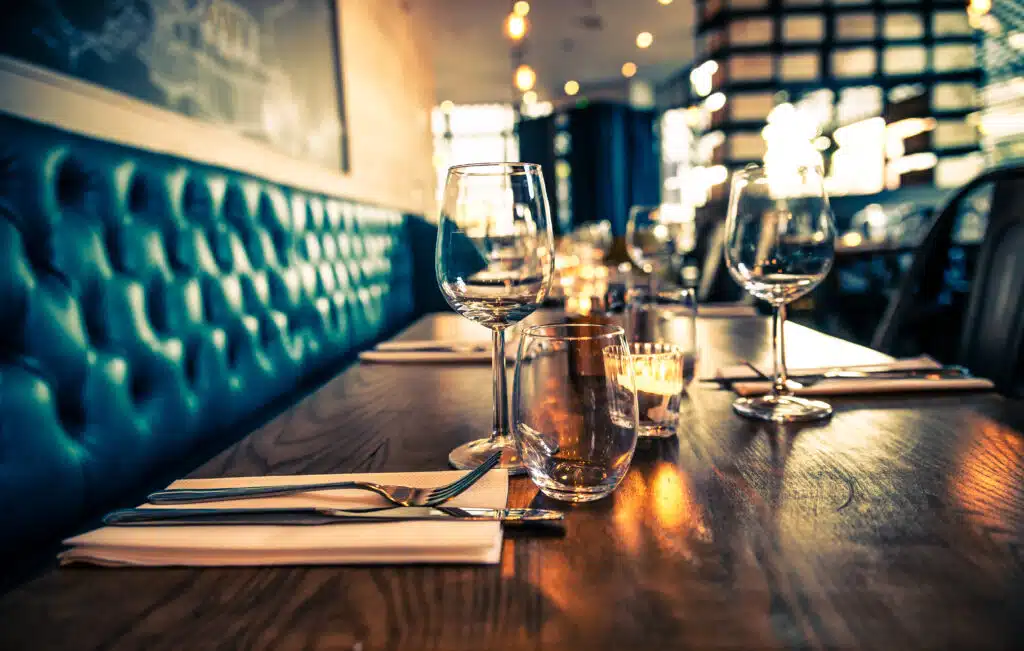
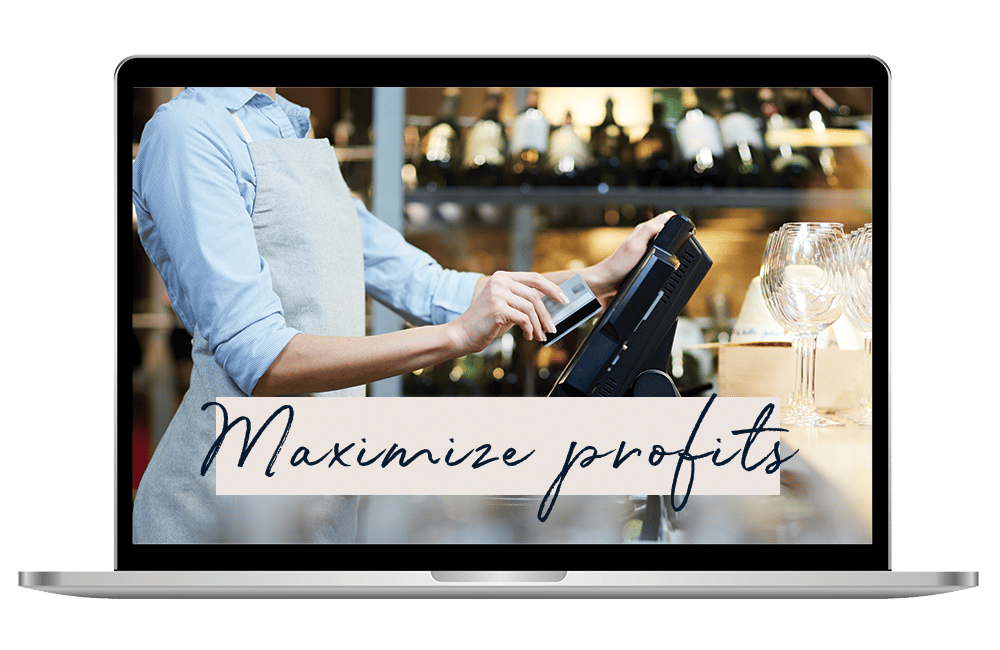
The three costly mistakes you could unknowingly be making?
Find out in this FREE guide and restaurant assessment specifically designed to reveal the unexpected hurdles standing between you and exponential business growth.
Thank You To Our Sponsors
Did You Know That 7 out of 10 Adults Dine Out To Celebrate Birthdays?
You Can Easily Capture This Lucrative Business!
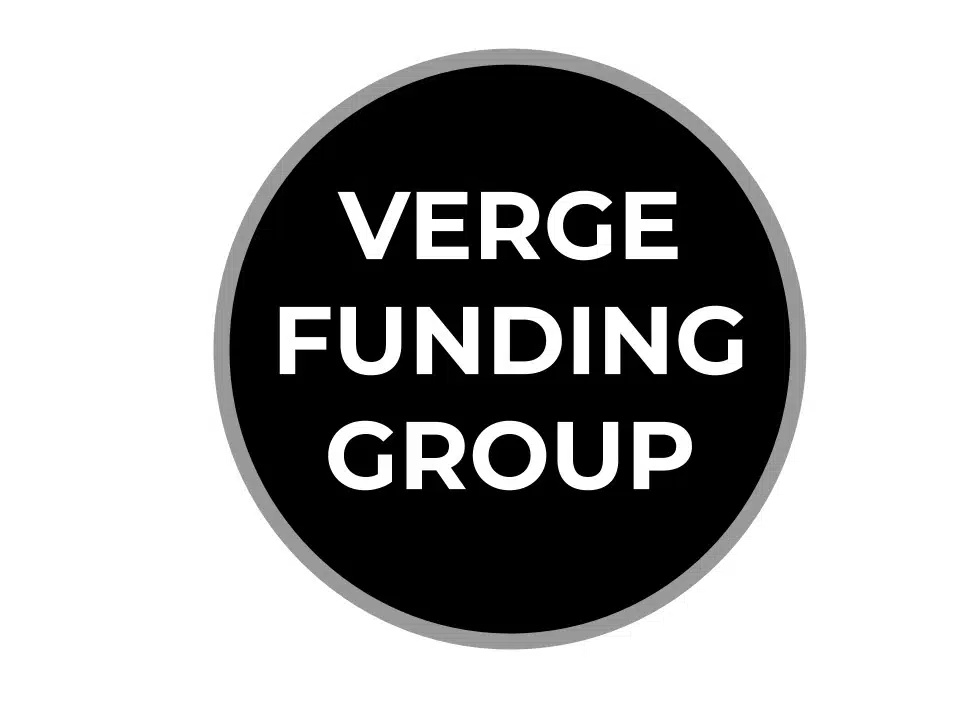
Find Out How Much Your Business Is Due Back from the ERC Program
Set Up a Call with Karen the Owner of Verge Funding
For a limited time only, popmenu is offering our listeners $100 off your first month plus an unchanging lifetime rate.
Request a DEMO:
Want to become a podcast sponsor?
Please get in touch with Roger at roger@restaurantrockstars.com
